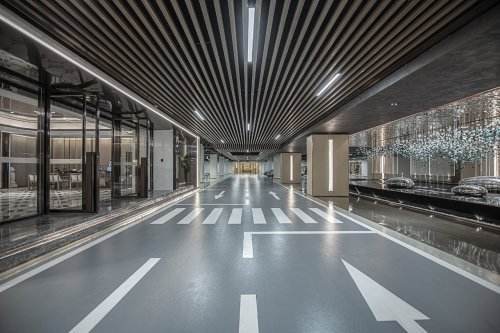Asymmetric and Symmetric Lighting: Which is Better?
Table of Contents
When choosing floodlights, beam angles can be perplexing. To navigate this, it’s essential to understand the beam designs of various lights. The most prevalent LED lighting designs are asymmetric and symmetric. These designs are pivotal in achieving the desired lighting ambiance.
The primary distinction between asymmetric and symmetric Lighting lies in their light distribution. Asymmetric lights focus their beams in a specific direction, minimizing unwanted glare and light pollution. On the other hand, symmetric lights distribute light uniformly in all orders, which can sometimes result in both intended and unintended glare.
There’s more to consider when deciding between these two lighting styles. This article delves into the advantages, drawbacks, and applications of both. Keep reading for a deeper understanding.

Understanding Asymmetric Lighting:
Asymmetric lights target a particular zone. They have a reflector acting as a mirror, concentrating beams and preventing them from scattering everywhere. This ensures reduced light pollution and glare. Typical applications include streetlights, stadium lights, and theater illumination.
A Glimpse into the History of Asymmetric Lighting:
The debut of the asymmetric light fixture was in the 1960s. Its inception aimed to provide consistent Lighting on surfaces. With numerous enhancements over the years, today’s asymmetric lights cater to various applications.
Defining Symmetric Lighting:
Ideal for brightening extensive areas, symmetric lights disperse light consistently in all directions without a focal point. Such Lighting is often chosen for outdoor and accent illumination. Moreover, it’s also suitable for indoor spaces and garages.

Distinctions Between Asymmetric and Symmetric Lighting
Here are the variations between asymmetric and symmetric Lighting:
| Asymmetric Lighting | Symmetric Lighting |
| Asymmetric Lighting enlighten a specific area in a definite direction. | Symmetric Lighting spreads in all directions equally. |
| This Lighting is ideal for focusing on a small area. | In illuminating a large area, symmetric Lighting works best. |
| Unintended glaring is reduced with asymmetric Lighting. | Symmetric Lighting causes intended and unintended glare. |
| Asymmetric Lighting prevents light pollution. | This Lighting causes light pollution. |
| This Lighting produces a narrow beam angle. | A wider bim angle is created in Symmetric Lighting. |
| Such Lighting is an effective solution for the workplace. | Symmetric lights are adequate for general Lighting. |
| Asymmetric Lighting reduces eye strain. | As symmetric Lighting produces unnecessary glaring, it causes eye strain. |
| The brightness of the light is different in different directions. | Light brightness is equal in all directions. |
| Asymmetric lights are energy-efficient. | Such lighting wastes energy. |
| Nearly no backlight is produced in asymmetric Lighting. | Symmetric light creates backlighting. |
| Best For Focusing on a Specific Region Workspace and street lighting | Best For General Lighting of ample area accent Lighting |
Comparing Asymmetric and Symmetric Lighting: Which Stands Out?

Let’s delve into the distinctions between asymmetric and symmetric Lighting to determine the superior choice:
- Asymmetric lighting targets specific areas, avoiding unnecessary illumination and, in turn, minimizing light pollution. On the other hand, symmetric Lighting disperses light broadly, inadvertently illuminating spaces and leading to potential light pollution.
- Symmetric Lighting can cause glare, resulting in eyestrain. Asymmetric Lighting, in contrast, directs its glare to specific angles, minimizing undesired brightness and lessening eye discomfort.
- Asymmetric lights use reflectors to produce focused light, optimizing energy consumption. Conversely, symmetric lights can be inefficient, often illuminating spaces needlessly and using more energy.
- While symmetric lights excel at illuminating vast spaces, asymmetric lights zero in on specific areas, making them less suitable for extensive spaces.
Pros of Asymmetric Lighting
- Targeted Illumination: Asymmetric Lighting excels in highlighting specific areas. If you want to emphasize a particular section of a room or space, it’s an ideal choice. The focused approach ensures that only the desired area gets illuminated.
- Efficient Use of Light: Asymmetric Lighting ensures there’s no wasted light. By concentrating only on the necessary areas, it reduces light pollution.
- Optimized Light Source: This type of Lighting employs narrow beams to target certain zones without any light spillage. It’s energy-efficient and reduces the necessity for additional lighting sources.
- Cost Benefits: By directing light precisely and using energy more efficiently, asymmetric Lighting can lead to savings on your electricity bills.
- Mood Setting: Depending on its application, asymmetric Lighting can set various moods, from mysterious and dramatic to soft and romantic.
- Emphasizing Texture: The contrast created by bright and shadowed areas can bring out the texture of objects, making them appear more tactile and detailed.
- Facial Contouring: In portrait photography, asymmetric Lighting can help emphasize or de-emphasize facial features, such as highlighting cheekbones or deepening eye sockets. This can be particularly useful in character-driven or artistic shots.
- Highlighting Volume: It can emphasize the volume of objects, showcasing their form more dynamically than even lighting might.
- Natural Look: Despite its dramatic appearance, it can often resemble natural lighting situations, such as sunlight coming in from a window.
- Flexibility: Asymmetric lighting setups are adaptable. Photographers and cinematographers can adjust the degree of asymmetry based on the desired effect, making it a versatile tool in their kit.
- Enhancing Storytelling: Lighting plays a crucial role in storytelling in film and theater. Asymmetric Lighting can emphasize conflict, tension, or mystery in a scene.
- Economic Efficiency: Instead of using multiple lights to evenly illuminate a scene, a filmmaker or photographer might use fewer lights to create an asymmetric effect, potentially saving on equipment and energy costs.
- Accentuating Movement: When used in the right scenarios, such as dance performances or sports, asymmetric Lighting can accentuate movement, making the motion of subjects more pronounced and visually striking.
- Creates Atmosphere: In stage productions or themed environments like restaurants or attractions, asymmetric Lighting can create a unique atmosphere or ambiance that immerses visitors.
- Less is More: Sometimes, the beauty of a subject is more pronounced when parts of it are left in shadow. Asymmetric Lighting can help emphasize this principle, creating a more captivating result.
Cons of Asymmetric Lighting
However, there are specific considerations to bear in mind:
- Limited Application: It’s not designed for broad or general lighting needs but for specific visual tasks.
- Potential for Uneven Lighting: The absence of backlight means certain areas might be left in shadow, necessitating supplementary Lighting for complete room illumination.
- Not Suitable for All Subjects: Some subjects or themes may not benefit from the dramatic mood of asymmetric Lighting. For instance, product photography or corporate headshots typically favor even, flattering light.
- Can Exaggerate Imperfections: The dramatic contrast created by asymmetric Lighting can highlight skin blemishes, wrinkles, or other imperfections in portrait photography.
- Challenging for Color Grading: In post-production, the high contrast and pronounced shadows can pose challenges for color grading or when trying to achieve a particular look.
- Potential for Overuse: Like any stylistic technique, there’s a danger of overusing asymmetric Lighting. It can become a crutch or a go-to style, making the output look repetitive or predictable.
In summary, while asymmetric Lighting offers several benefits, it’s essential to understand its limitations before incorporating it into your design plans.
Applications of Asymmetric Lighting
Having understood the advantages of asymmetric Lighting, you might be curious about its potential applications. Asymmetric Lighting can be implemented in both open and closed environments. Here are some popular settings where it is commonly used:

Workspace
Asymmetric Lighting is adept at targeting specific areas with light. This makes it ideal for illuminating workspaces such as office desks, study areas, and cooking counters.
Stadiums
For stadium lighting, asymmetric lights are top-notch. They primarily concentrate on the field, enhancing the viewing experience for spectators by minimizing glare and unexpected bright spots.
Roadways
Asymmetric Lighting is often synonymous with streetlights. These lights are strategically placed on roads to illuminate particular sections, curtailing light pollution.
Theatres
In theatres, the focus is usually on the stage while the audience area remains dim. Asymmetric Lighting serves this purpose flawlessly by lighting up only the scene and not the entire auditorium.
Beyond these, asymmetric lights have versatile applications. For instance, they can accentuate a specific corner of a room, lending an artistic touch to your interior décor.
Benefits of Symmetric Lighting
Symmetric Lighting offers the following advantages:
- Broad Illumination: Symmetric Lighting disperses light evenly in all directions, making it a top choice for illuminating expansive areas.
- Consistent Light Distribution: Instead of focusing on specific spots, symmetric Lighting ensures a steady and even light spread, making it ideal for general illumination.
- Facilitates Visibility: By lighting up the entire space, symmetric Lighting ensures clear visibility throughout, aiding in activities requiring consistent room lighting.
Drawbacks of Symmetric Lighting
On the flip side, symmetric Lighting comes with some disadvantages:
- It can result in both desired and unwanted light glare.
- Potential for causing eye strain.
- Risk of light pollution due to illumination of unnecessary areas.
- Less energy-efficient when compared to asymmetrical Lighting.
It’s essential to weigh these concerns before opting for symmetric lighting installations.
Where Should Symmetric Lighting Be Applied?
Symmetric Lighting is prevalent in many everyday settings. Here are some typical applications of symmetric Lighting:

Expansive Open Areas
Symmetric Lighting is ideal for illuminating vast open areas, whether at a fair or an outdoor gathering. This type of Lighting is often chosen for events and functions due to its ability to cover large spaces.
Storage Units
Within warehouses, items are often stacked closely together. Symmetric Lighting proves beneficial in such packed environments, ensuring clear visibility.
Indoor Lighting
The lights we use in our bedrooms, living rooms, offices, shopping malls, etc., are generally symmetric. Such Lighting is in demand for regular usage as it illuminates the entire area of your room equally.
Outdoor Parking Lots
For open-air parking zones, symmetric Lighting helps brighten up every vehicle. This allows you to spot your car quickly, even from afar, amidst many others.
Understanding Symmetrical vs. Asymmetrical Lighting
You’ve delved into symmetrical and asymmetrical Lighting. But what about distinguishing between the two? Let’s break down the methods to pinpoint them:
1. Light Flow Direction
Symmetrical Lighting shines in both forward and backward directions. In contrast, asymmetrical Lighting avoids casting light backward. You look at balanced lighting if there’s a consistent distribution in every order.
2. Beam Spread
Symmetrical Lighting showcases a wide beam angle that distributes light equally on both sides. On the other hand, asymmetrical Lighting has a more uneven spread, resulting in a tighter beam angle. Observing these angles will help you differentiate.
3. Glare Effects
Symmetrical lights often lead to intentional and unintentional glares due to their all-encompassing illumination. If you encounter areas illuminated unnecessarily, causing discomfort to your eyes, it’s symmetrical. Conversely, if the light is concentrated on a distinct object or place, it indicates asymmetrical Lighting.
4. Contrast of Dark and Light
The unique feature of asymmetrical Lighting is its ability to highlight a particular area while leaving surrounding regions shadowed. This creates a noticeable dark-to-light transition. But if the light is uniformly dispersed without shadowy patches, you observe symmetrical Lighting.
Armed with these insights, distinguishing between symmetrical and asymmetrical Lighting becomes effortless.
Final Thoughts
Both asymmetrical and symmetrical Lighting play pivotal roles in indoor and outdoor illumination. While they differ in many ways – balanced lights provide even coverage ideal for expansive spaces, whereas asymmetrical lights emphasize specific zones – their applications are versatile and often cost-effective.
Choose the Lighting that best fits your needs. And when you do, consider MyLikeLed. We offer premium LED strips and LED neon flex, all customizable to your desired beam angles. Each of our offerings undergoes rigorous testing and certification. For top-tier lighting solutions for your endeavors, reach out to us!
FAQs
Use symmetric lighting for general illumination, like in open spaces, offices, or retail stores where even light distribution is needed across the entire area.
Asymmetric lighting is better for focused or directional lighting, such as on walls, signs, pathways, or shelves, where you want to avoid glare and illuminate a targeted area efficiently.
For outdoor areas like parking lots, pathways, or building facades, asymmetric lighting is often better because it directs light exactly where needed without light spill.
Symmetric lighting can cause more glare if not positioned properly, especially in task areas. Asymmetric fixtures are designed to reduce glare by focusing light away from direct lines of sight.
Asymmetric lighting tends to be more energy-efficient in targeted applications since it avoids lighting unused areas, while symmetric lighting may waste light in some setups.
Choose symmetric lighting for even, widespread illumination and asymmetric lighting for directional, task-specific, or accent lighting. The choice depends on your space, lighting goals, and efficiency needs.

Hi, I’m Xylia Xiong, a sales professional with 14 years of experience in the LED strip light industry. I specialize in providing tailored solutions, leveraging my expertise in LED products and the latest industry trends. Known for effective communication and problem-solving, I’m dedicated to helping lighting manufacturers, importers, and distributors achieve their goals.
Let’s work together to create customized solutions that exceed expectations.
Related Posts

The Best LED Strip Lights You Can Buy Right Now

Comparing WS2811 Vs WS2812B: Key Differences


